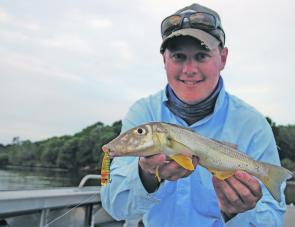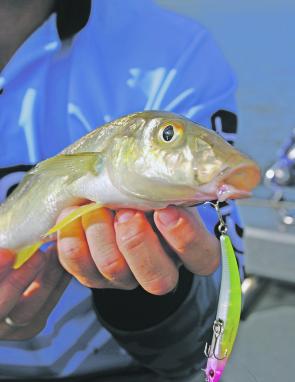It felt like it had been blowing northerlies for most the last month, which has made fishing the bay quite difficult. I’m sure I’m not the only one who has been focusing a lot of my time up the rivers and in the canals.
Northerly winds and hot, humid days come hand in hand. In turn, the water temperature has heated up in some of these backwaters and the estuary systems have started to fire up.
With summer now in full swing I have two estuary species that I really enjoy chasing on lures and soft plastics: summer whiting and mangrove jack. Growing up fishing Moreton Bay, the desire to chase mangrove jack was never really strong, because it was something out of the norm. It’s only been in the last two years that I have put in the hard work to specifically target them locally and on the Gold Coast.
For those of you who have always wanted to catch one but never have, the first piece of advice I would give to you is to persist. A session targeting jacks isn’t like a session targeting bream or flathead where you could catch 5-10 or more in a day. You may only have one strike in a session, or two or maybe three if you are lucky. So persistence and patience are a big part of jack fishing.
The best conditions for chasing jacks may not be the most pleasurable, as it quite often hot and humid and in a river system when this coincides with dawn or dusk, the mozzies and sand flies come out to feast. So take some insect repellent.
Areas to begin looking for mangrove jack would be any fully or semi submerged trees, rock bars and walls, bridge pylons and pontoons, all of which will hold jacks at some stage. You will find that particular structure will fire at different stages of the tide so moving around throughout the day will help your chances of landing a jack.
When casting lures at structure whether it is a pontoon, rock bar or fallen tree try to get your lure as close as possible to the structure without snagging up. If your lure is not right next to the structure then that could be the difference between getting a fish or not getting a fish. To minimise snagging up, rig your soft plastics up weedless. The plastics that I find that are the most successful would be the 4” Z-Man Swimmerz, these matched a TT Snagless Weight System (SWS) jighead in a 1/8ozdepending on the depth and tidal movement in the area that you are fishing.
I’ve found using a slow rolling retrieve to be most effective coming out of a snag or under a pontoon. Using a hoping action when working the lure down a rock wall or along a rock bar also works well.
The last piece of advice I can give you is stay consistently focused on what you are doing because the moment you lose concentration may be the moment your lure gets annihilated by a jack. They only need that split second to take you back in and around a rock or tree and bust you off.
Recently I was lucky enough to go down to Evans Head for a week of fishing and surfing with some mates. We focused a lot of our time up the river targeting whiting on surface lures. As I was the only one who had fished for whiting on surface lures, the rest of the boys were a little sceptical of whiting coming up to hit a surface lure.
It didn’t take long for that perception to change. Within 10 minutes of arriving and casting we were on to some great summer whiting. The trick to using surface lures for whiting is to not stop the twitching action of the lure. The moment you stop the lure when a whiting is following he will shy away from the lure straight away. I will generally work these lures in 1-4ft of water depending on how windy it is.
Surface lures work for whiting because they come to the top to feed on small prawns and these lures imitate a fleeing prawn. Both poppers and stickbaits work well on the whiting. If there is a slight chop on the water then a popper will work better as they make a little more of a disturbance on the surface.
The lures that I use on a regular basis are the Zip Bait ZBL poppers, Sebile Splasher 52mm, OSP Bent Minnow and the Lucky Craft NW pencils. It is also important if you are running fluorocarbon leader to keep it quite short as it sinks and if it is too long, it will pull your lure under during the retrieve.
We had a week of throwing lures at these aggressive hard fighting fish and with not a whiting under 30cm all week; they were awesome fun on light gear.
If you have any queries or questions on anything that I have written in this month’s column or enquires about products I have mentioned, please don’t hesitate to come down and see us at Fish Head in the Victoria Point Town Centre.
Reads: 4509
Whiting at this size pull just as hard as any other species on light gear. This fish went 39cm and was caught on a Zip Bait ZBL popper.

Whiting are not afraid of going for slightly bigger lures either. This OSP Bent Minnow measures 76mm and accounted for a lot of fish on this trip, including this 39cm model.

Small snapper like this one caught by Dennis Klau are still readily available during the warmer months.

A 54cm jack caught rolling a 4” Z-Man Swimmerz in pearl. Working these just below pontoons is a deadly retrieve.

Even when using a larger profile 4” plastic average size jacks like this one will still engulf them.




